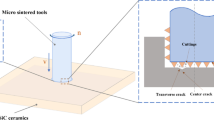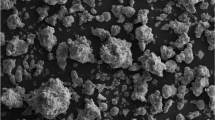Abstract
SiC ceramic materials are extremely hard and brittle materials, and are prone to defects such as cracks during processing. It is sensitive to cutting parameters and other processing conditions, making the material extremely difficult to process. This research investigates the material removal mechanism, as well as the influences of cutting parameters and tool wear on the brittle-ductile transition. The relationship between cutting parameters such as feed rate and cutting depth and the ductile–brittle transition was obtained according to the critical load model for brittle material fracture and SiC chip thickness model. Milling tests were conducted, and it was found that with the increase of feed rate and cutting depth, the occurrence of brittle removal increased, and the material removal mode shifted from ductile removal to brittle removal. By the characteristics analysis of force distribution in time–frequency domain, the existence of brittle-ductile transition in SiC milling was proven combined with the analysis of surface roughness and chip morphology. A comprehensive basis for judging the critical transition was provided that the range of parameters is feed rate of 0.015–0.02 mm/z and cutting depth of 0.15–0.2 mm. Tool wear is another significant impact factor on the material removal mode during the milling process. When the tool is worn, it is easier to undergo brittle removal compared to non-worn tools with the same cutting parameters. The brittle-ductile cutting mode of diamond tool milling SiC ceramics and its influence on the cutting force coefficient were also studied based on the milling geometric model. The cutting force mixed with brittle removal and ductile removal is not suitable for identifying the cutting force coefficient.


















Similar content being viewed by others
References
Wenbo Z, Honghua S, Jianbo D, Tengfei Y, Yihao Z (2018) Numerical investigation on the influence of cutting-edge radius and grinding wheel speed on chip formation in sic grinding. Ceram Int 44:21451–21460
Zhang K, Su H, Xu W (2014) Influence of plate wheel dressing of monolayer brazed diamond wheel on material removal mechanism in SiC grinding, Journal of Nan**g University of Aeronautics and Astronautics 46(5):732–737
Li Z, Zhang F, Luo X, Chang W, Cai Y, Zhong W (2019) Material removal mechanism of laser-assisted grinding of rb-sic ceramics and process optimization. J Eur Ceram Soc 39:705–717
Chang CW, Kuo CP (2007) An investigation of laser-assisted machining of Al2O3 ceramics planning. Int J Mach Tool Manu 47(3–4):452–461
Zhang S, Qi YZ, Chen JY (2023) Brittle-ductile transition behavior of 6H-SiC in oblique diamond cutting. Int J Mech Sci 246:108155
Sun ZW, To S (2023) Ductile Machining Mechanism for Micro-structure by Ultra-precision Raster Milling. In: To S, Wang S (ed) Fly Cutting Technology for Ultra-precision Machining. Springer, Singapore, pp 305–326
Cao J, Nie M, Liu Y (2018) Ductile-brittle transition behavior in the ultrasonic vibration-assisted internal grinding of silicon carbide ceramics. Int J Adv Manuf Tech 96:9–12
Zhang Y, Li C, Ji H, Yang X, Yang M, Jia D, Zhang X, Li R, Wang J (2017) Analysis of grinding mechanics and improved predictive force model based on material-removal and plastic-stacking mechanisms. Int J Mach Tools Manuf 122:81–97
Zhao L, Zhang JJ, Zhang JG, Hartmaier A (2020) Atomistic investigation of machinability of monocrystalline 3c-sic in elliptical vibration-assisted diamond cutting. Ceram Int 47:2358–2366
Yang M, Li C, Zhang Y, Jia D, Li R, Hou Y, Cao H (2019) Effect of friction coefficient on chip thickness models in ductile-regime grinding of zirconia ceramics. Int J Adv Manuf Tech 102:2617–2632
Chen ST, Yang KC (2022) Semi-ductile cutting regime technology for machining Zerodur glass-ceramic microstructures. Precis Eng 74:92–109
Priyadarshini M, Pradhan S, Samantray R (2023) Methods for ceramic machining. in: Gupta R K, Behera A, Farhad S (ed) Advanced Flexible Ceramics. Elsevier, Amsterdam, pp 243–257
Demarbaix A, Ducobu F, Juste E, Petit F, Duterte C, Lorphèvre ER (2021) Experimental investigation on green ceramic machining with nanosecond laser source. J Manuf Process 61:245–253
Fan MX, Zhou XQ, Song JZ (2024) Experimental investigation on cutting force and machining parameters optimization in in-situ laser-assisted machining of glass–ceramic. Opt Laser Technol 169:110109
Rao X, Zhang F, Liu L (2016) Surface characteristics for RB-SiC ceramics by electrical discharge diamond grinding. Opt Precis Eng 24(9):2192–2199
Liu YH, Ji RJ, Li Q, Yu L, Li X (2009) An experimental investigation for electric discharge milling of sic ceramics with high electrical resistivity. J Alloy Compd 472(1–2):406–410
Guo YF, Feng YR, Wang L (2018) Experimental investigation of EDM parameters for zrb2-sic ceramics machining. Procedia CIRP 68:46–51
Mohri N, Fukuzawa Y, Tani T, Saito N, Furutani K (1996) Assisting electrode method for machining insulating ceramics. CIRP Ann-Manuf Techn 45(1):201–204
Sánchez JA, Cabanes I, Lacalle LNLD, Lamikiz A (2001) Development of optimum electrodischarge machining technology for advanced ceramics. Int J Adv Manuf Tech 18(12):897–905
Goel S, Luo X, Comley P, Reuben RL, Cox A (2013) Brittle–ductile transition during diamond turning of single crystal silicon carbide. Int J Mach Tool Manu 65(2):15–21
Liang Z, Wang X, Wu Y (2013) Experimental study on brittle - ductile transition in elliptical ultrasonic assisted grinding (euag) of monocrystal sapphire using single diamond abrasive grain. Int J Mach Tool Manu 71(8):41–51
Wang B, Liu Z, Su G (2015) Investigations of critical cutting speed and ductile-to-brittle transition mechanism for workpiece material in ultra-high speed machining. Int J Mech Sci 104:44–59
Beaucamp A, Simon P, Charlton P, King C, Matsubara A, Wegener K (2017) Brittle-ductile transition in shape adaptive grinding (SAG) of SiC aspheric optics. Int J Mach Tool Manu 115:29–37
**ao G, To S, Zhang G (2015) Molecular dynamics modelling of brittle–ductile cutting mode transition: Case study on silicon carbide. Int J Mach Tool Manu 88:214–222
Marshall DB, Lawn BR (1985) Indentation of brittle materials, micro indentation technology in materials science and engineering. International Metallographic Society 1:889
Shamray S, Azarhoushang B, Paknejad M, Buechler A (2022) Ductile-brittle transition mechanisms in micro-grinding of silicon nitride. Ceram Int 48(23):34987–34998
Malkin S (1989) Grinding technology: theory and applications of machining with abrasives, Wiley, New York
Arif M, Rahman M, San WY (2012) Analytical model to determine the critical conditions for the modes of material removal in the milling process of brittle material. J Mater Process Tech 212(9):1925–1933
Jacob J (2014) Determination of the ductile to brittle transition and critical depth of cut in 6H-silicon carbide through fly cutting. https://www.researchgate.net/publication/237675955_DETERMINATION_OF_THE_DUCTILE_TO_BRITTLE_TRANSITION_AND_CRITICAL_DEPTH_OF_CUT_IN_6H-SILICON_CARBIDE_THROUGH_FLY_CUTTING
Scattergood O, Blake N (1990) Ductile-regime machining of germanium and silicon. J Am Ceram Soc 73(4):949–957
Hiroaki T, Shoichi S (2013) Damage-free machining of monocrystalline silicon carbide. CIRP Ann-Manuf Techn 62(1):55–58
Qiao Y, Argon AS (2003) Brittle-to-ductile fracture transition in fe–3wt.%si single crystals by thermal crack arrest. Mech Mater 35(9):903–912
Toshihiko H, Tomokazu K, Atsushi H (2012) Surface roughness control based on digital copy milling concept to achieve autonomous milling operation. Procedia CIRP 4(4):35–40
Zhou M, Wang XJ, Ngoi BKA, Gan JGK (2002) Brittle - ductile transition in the diamond cutting of glasses with the aid of ultrasonic vibration. J Mater Process Tech 121(2–3):243–251
Campbell GH, Dalgleish BJ, Evans AG (2010) Brittle-to-ductile transition in silicon carbide. J Am Ceram Soc 72(8):1402–1408
Acknowledgements
This work is supported by Key Research and Development Program of Shandong Province, China (No. 2022CXGC010201), National-Local Joint Engineering Laboratory of NC Machining Equipment and Technology of High-Grade stone SJSC-2015-11, China. The authors would like to express their appreciation to the agencies.
Author information
Authors and Affiliations
Corresponding author
Ethics declarations
Conflict of interest
The authors declare no competing interests.
Additional information
Publisher's Note
Springer Nature remains neutral with regard to jurisdictional claims in published maps and institutional affiliations.
Rights and permissions
Springer Nature or its licensor (e.g. a society or other partner) holds exclusive rights to this article under a publishing agreement with the author(s) or other rightsholder(s); author self-archiving of the accepted manuscript version of this article is solely governed by the terms of such publishing agreement and applicable law.
About this article
Cite this article
Qiu, J., Ge, R. & Han, T. Material removal mechanism of brittle-ductile transition in milling SiC ceramic and experimental verification. Int J Adv Manuf Technol (2024). https://doi.org/10.1007/s00170-024-13931-y
Received:
Accepted:
Published:
DOI: https://doi.org/10.1007/s00170-024-13931-y




